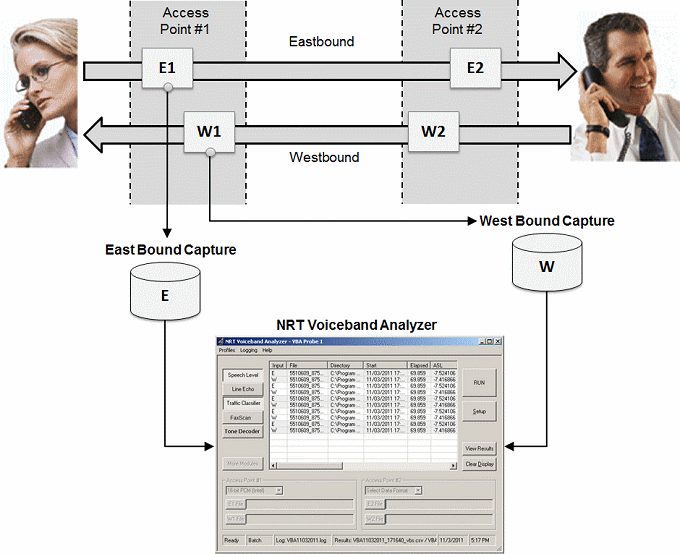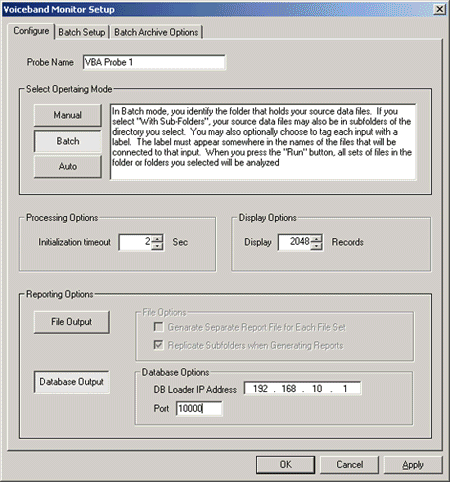GL Announces Enhanced Voice-Band Analyzer
Welcome to another February 2015 issue of GL Communications' newsletter providing information and insight into our enhanced Near Real-time Voice-band Analyzer - An analysis tool for monitoring the quality of voice-band traffic over TDM, VoIP and Wireless networks.

Introduction
The Near Real-time Voice-band Analyzer (VBA) is a versatile analysis tool that helps monitoring voice band traffic over variety of networks including VoIP, TDM, 2-Wire and Wireless. It can host an arbitrary number of analysis algorithms.
Built-in algorithms include ITU-T P.56 Active Voice Level analysis, Line Echo (Hybrid) analysis, and licensed modules include 2-Wire Echo Analysis, Traffic Classifier and Fax analysis. Other analysis modules such as ITU-T P.561, P.562, and P.563 can also be hosted as plug-ins.
The VBA application operates on previously captured files, making it a near-real time (as opposed to a strictly real-time) tool. It supports A-Law, μ-Law, 16-bit PCM (Intel), 16-bit PCM (Motorola), MS Wave, G.726 (40 Kbps, 32 Kbps, 24 Kbps, and 16 Kbps), and G.722 (64 Kbps) file formats.
VBA records its output into two files, the first containing overall channel measurements, and the second containing event records. It produces summary measurements of the captured signals, including active speech levels, noise level, percent time active, DC offset and the like.
The optional VBA FaxScan™ module can be used to analyze both 2-wire and 4-wire voice-band captures for Fax traffic and output fax signaling frames in a log file and fax image in TIFF format.
VBA works in conjunction with GL's TDM, Packet, and Wireless non-intrusive capture products:
- VBA with GL's TDM T1 E1 Call Capture and Analysis, or
- VBA with GL's VoIP PacketScan™ / MLPPP Analyzer
- VBA with GL's GSM, CDMA, and 3G Call Capture Products
- VBA with GL's 2-Wire Voice/Data Capture Products
Some of the Important Features
- Near real-time (NRT) non-intrusive analysis platform
- Supports 1, 2, 3, and 4-port signal data analysis
- Manual, batch, and automatic processing modes
- Accepts A-Law, µ-Law, 16-bit PCM (Intel), 16-bit PCM (Motorola), MS Wave, G.726 (40 Kbps, 32 Kbps, 24 Kbps, and 16 Kbps), and G.722 (64 Kbps) input data formats
- Allows to implement Psophometric and C-Message signal conditioning before the Active Speech Level analysis; reports C-Message filtered files in dBrnC
VBA Algorithms (Built-in and Optional)
- Active Speech Level measured in accordance with P.56 Method B
- Hybrid Echo analysis module for Line Echo measurement. It outputs Echo Return Loss - ERL (dB), Echo Delay (ms), and Echo Dispersion (ms) values
- Traffic Classifier to detect, classify, and display the amount of traffic - whether its Fax, Voice, Digits , Tones, or Silence present in the network
- FaxScan™ used to analyze voice band traffic files for Fax traffic on 2-wire or 4-wire captures. It outputs fax signaling frames in a log file and Fax image in TIF format
- Tone Decoder can detect and decode the following different types of phone tones -
- DTMF, MF
- Caller ID, Caller ID - Call Waiting
- Paging Tones
- Teletype (TTY)
- Frequency-Shift Keying (FSK)
- Specific Area Message encoding (SAME)
- Visual Message Waiting Indication (VMWI)
- Special Information Tone (SIT)
- Silence, ring-back, busy tones or any Custom Tones from the PCM wave file / wave streams
Modes of Operation
As depicted in the below screenshot, the VBA operates in three fundamental modes: Manual, Batch and Automatic.

In the Manual mode the user specifies manually the files to be analyzed. Simultaneously two sets of files can be analyzed with appropriate data format selected.
In the Batch mode, users can analyze an entire set of assembled data files in a folder or in subfolders at once. File naming conventions are used to group files and identify the appropriate input for each file. The results are recorded and stored in a destination folder in *.CSV format, where they may be viewed with spreadsheet applications such as Microsoft® Excel.
The Automatic mode is similar to Batch processing, except the process continues indefinitely until the user manually stops the execution. The specified folders are continuously scanned for the arrival of new files. The results are recorded and stored in a destination folder in *.CSV format, where they may be viewed with spreadsheet applications such as Microsoft® Excel.
Further GL's VoIP & TDM probes gather information intrusively and feed it to VBA for analysis. The VBA then instantly detects the voice file captures and stores the results if necessary. The real-time and historic data collected by the probes can be output to a remote database by configuring the options.
GL's web server will provide real-time and historic views of the data through various "browser based" clients.
Voice-band Analysis Reports and Events
Call Events
The Voice-band Events output file contains various signaling (ISDN, CAS, SS7) events, start time, event duration, and so on.
Call Summary
The Voice-band Summary or Status output file contains an overall summary of the call, including the input direction (E / W), the call duration, the elapsed time and various measurements based on the modules selected.
VBA FaxScan™ Report
VBA FaxScan™ always outputs the Fax image as a TIFF (“Tagged Image File Format”) file and a Log File.



 Back to Newsletter Index Page
Back to Newsletter Index Page